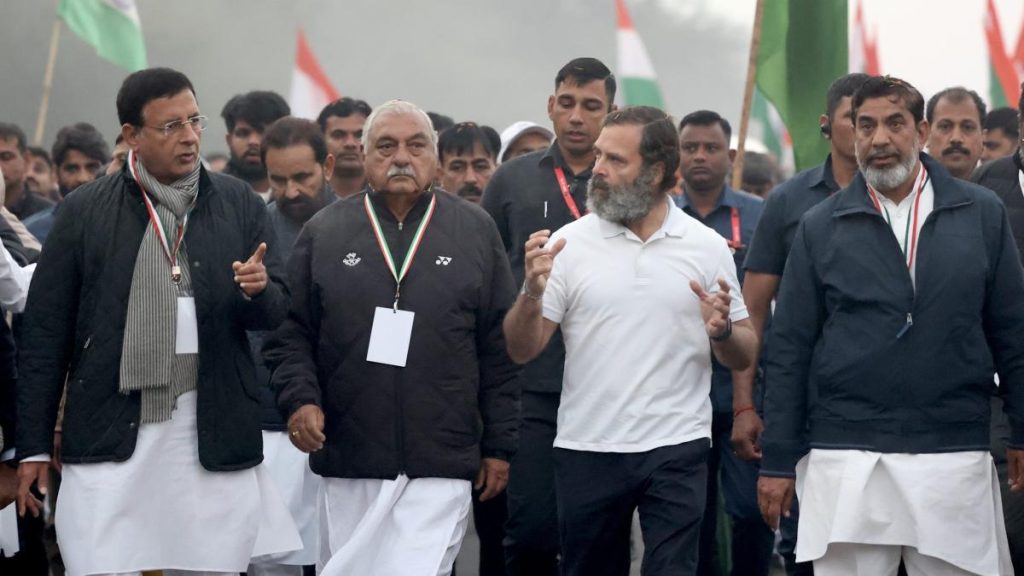On January 30, Congress president Rahul Gandhi completed his Bharat Jodo Yatra (BJY) in Srinagar. He was satisfied after five months. After walking nearly 4,000 kilometres, the final ceremony in Srinagar had to go smoothly despite the bitter cold and snow. He was happy to play snowballs or sheen mubarak with his sister Priyanka.

He originally planned to end his Ekta Yatra at Raj Ghat, but the day before he decided to hoist the national flag at Lal Chowk, like Dr. Murli Manohar Joshi and PM Narendra Modi did in 1992. Rahul Gandhi waved the flag at Lal Chowk after dismissing it as a BJP-RSS stronghold, resembling Modi twenty years earlier.
In December 1991, during the height of J&K terrorism, Modi organised Dr. Murli Manohar Joshi’s Ekta Yatra from Kanyakumari to Kashmir. After travelling 14 states in two months, BJP leaders raised the national flag in Lal Chowk on January 26, 1992, despite separatist threats. Dr. Murli Manohar Joshi and his team, including Modi, were flown from Jammu to Srinagar in a military aircraft to hoist the flag to send a message to the separatists by the then-Congress administration under Prime Minister P.V. Narasimha Rao. Rahul’s J&K Bharat Jodo Yatra (BJY) was much calmer.

Normalcy has returned to Kashmir. After J&K’s special status was revoked on August 5, 2019, Union territory’s security improved. Representatives from several national and regional parties joined Rahul on stage to celebrate the end of his padyatra, despite the event’s many empty seats.
The Congress reportedly invited 23 “like-minded” opposition parties to the yatra’s grand finale, but many major parties, including the TMC, declined. After raising the tricolour at Lal Chowk in Srinagar, Rahul Gandhi said the march had “tremendous support and love from people along the route” and would have “effect on Indian polity, but what it will be, I can’t tell right now.” He seems unconcerned about the Srinagar opposition’s lack of support. His arrival thrilled Kashmiri political heavyweights in the Gupkar Alliance. According to Mehbooba Mufti, Rahul’s home is Kashmir, and the Congress will restore “Godse ideology has kidnapped from J&K.” Omar Abdullah wanted to go on another yatr with Rahul.

Rahul held “12 public gatherings, over 100 corner meetings, 13 press conferences, and 275 organised walking engagements” during his 136-day yatra, according to Congress media chief Jairam Ramesh. Because of the importance of transporting supplies in 60 containers, the BJP was the only party to ignore the yatra, calling it a “morning walk and evening stroll.” It was a voyage that changed Rahul’s image from “political” to “leader with an idea for India.” Despite some enigmas,
How does Rahul’s transformation affect the Congress as a whole? How will the party view him? After returning to Delhi, Rahul went straight to Lok Sabha for the Union Budget. However, Congress is in limbo. Political party members of the Gandhi family are awaiting the Gandhi scion’s actions. In the coming weeks, some senior party members are sceptical of Rahul and his inner circle’s contributions. It’s unclear if he’ll return to the spotlight. Some party members are also upset with Rahul for publicly shaming senior leader Digvijay Singh for his Army action comments. Why were you so harsh with Digvijayji? As Madhya Pradesh’s chief minister for ten years, he planned the Bharat Jodo Yatra. “This embarrassment would cost the Congress when we go to polls in MP,” says a veteran Congressman. Rahul made a mistake by needlessly mocking Union Home Minister Amit Shah and challenging him to take a yatra from Jammu to Srinagar. Who was Rahul’s security advisor? BJP Prime Minister Narendra Modi and Deputy Prime Minister Amit Shah can be criticised, but not individually. The BJP gains support from such attacks. A party leader says their members don’t “snipe” to bring down the opposition.

According to party insiders, Rahul and his staff are ecstatic about BJY’s “success.” Naturally, Rahul is aware that converting positive public sentiment toward him into party support will take a lot of work. As a BJY follow-up, the Haath se Haath Jodo (HSHJ) project was created. A former Congress lawmaker said, “If you are not seeing enough attendees at HSHJ, that is because we have lost our cadre.” If Congress had no representatives, what good would such programmes be? Winning over former cadre is the party’s issue.

